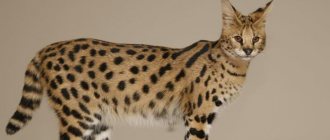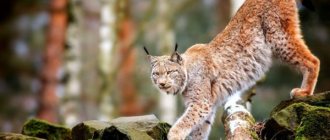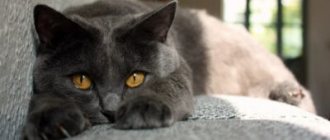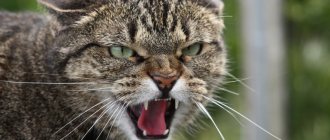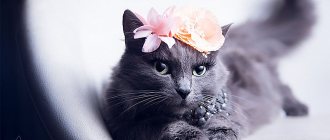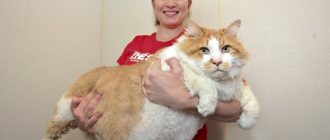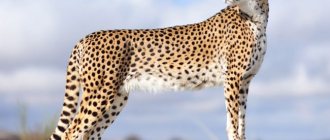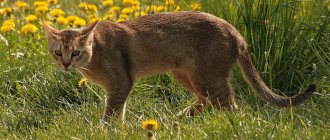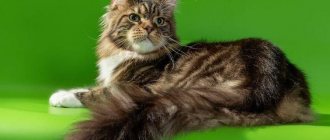How much does the biggest cat weigh?
It is known that the size of a predator depends on the size of its prey. Domestic cats, no matter what breed they belong to, hunt rodents, reptiles, and birds weighing up to 1 kg. The second important factor is the size of the ancestors. Domestic “tigers” have a Libyan wild cat (Felis silvestris lybica) weighing 4–7 kg. Therefore, the average weight of a pet rarely exceeds 3.5–4.5 kg.
An animal living in an apartment is more likely to gain excess weight than an animal living on the street due to the difference in physical activity. But the non-household pet will become longer or higher at the withers than its fellow tribesmen. To increase in size, you will need tall and massive ancestors. These are the breeds we will talk about.
The top 10 largest cats include:
- Siberian cat;
- ragamuffin;
- Turkish van;
- British Shorthair;
- chartreuse;
- Norwegian forest;
- ragdoll;
- khausi (chausi);
- savannah;
- Maine Coon.
Leopard or Asherah cat
Cats of this breed appeared relatively recently, they were bred by American geneticists led by the British entrepreneur Simon Brodie. The long-legged African Serval, which is the name given to the wild cat, and the Asian leopard predator were crossed.
As a result, biotechnologists got a cat - a leopard. She bears the name of the goddess Asherah. The goal of geneticists was to breed an animal that could be considered a perfect creature in all respects.
The leopard cat differs from other species of the cat family by its impressive size, menacing appearance, powerful paws, predatory grin and exotic appearance.
At the same time, Asher cats have typical habits of domestic pets and an easy-going and affectionate character. They, just like other individuals, love to play, cuddle and “sing” songs - they purr. These unpretentious creatures love to play and frolic with children. At the same time, they are careful and try not to scratch anyone.
Simon Brodie's employees developed hypoallergenic cats several years ago. This achievement will help many people have a furry, affectionate and beloved friend in their home. True, this desire can be expensive. A small Usher can cost around $22,000, but more often than not the amount is much higher.
If you buy a hypoallergenic cat, then you need to add about six thousand more to this amount.
By purchasing this pet, you get:
- complete vaccination of the individual;
- annual health insurance;
- identifier – a microchip implanted into the body of an individual;
- hygiene kit;
- special toys made from safe material;
- food that can be called not only dietary, but also elite;
- claw attachments made of vinyl included in the set;
- as well as a consultation with veterinarian Ronald Tripp for 10 years.
It is this luminary of veterinary science who is a recognized expert on cats; he knows better than others how to properly care for them.
Asher cats are recognized as the largest, but this fact is already disputed by the creators of the Savannah breed. The scandalous fame of the dispute is fueled by legal showdowns, during which DNA tests are even carried out.
Siberian cat
The exceptionally beautiful Siberian cat is already 1000 years old. Russian felinologists (this is the name given to specialists who study the anatomy, physiology and habits of domestic cats) believe that the first “Siberians” were brought to Russia by merchants from Central Asia. Over time, harsh climatic conditions forced cats to acquire long hair. Just like the Chartreuse, the Siberian cat grows up to 5 years. An adult male weighs 4–6 kg. The height of the male is 40 cm, the female is 30 cm.
View this post on Instagram
A post shared by Victor Ray (@v1cr4v)
The Russian breed standard was recognized by the World Cat Federation in 1991. Since the 2000s, the Siberian cat has been considered the national breed of Russia.
Cat breeds that appear big because of their fluffy fur
The last selection is “pet illusionists”. Their impressive dimensions are a decoy created by fluffy wool. The real proportions of such cats are clearly visible after bathing.
Turkish Angora (2.5-5 kg)
The fluffy and soft fur of the Turkish Angora hides a graceful and very slender body. Thick fur also covers the inside and tips of the ears. In addition to the common white color, the standard allows other colors, but due to their less popularity, their owners are always cheaper.
Turkish Angoras take a long time to get used to new people and are suspicious of strangers. There are no problems with other pets if their size matches the “mustachio.” Otherwise, the hunting instinct may awaken in him.
Himalayan (3.1-6.3 kg)
The thick and long fur coat gives the Himalayans a resemblance to a fluffy pom-pom. In addition to the awn, they have a well-developed undercoat, so without regular care, the hairs quickly become tangled and lose their luster.
INTERESTING!
“Himalayans” got their name from rabbits of the same name with a similar color.
By their nature, the “Himalayans” are close to the “Persians”. They are neat, peaceful and prudent. Petty hooliganism on their part is a rarity, due to their relationship with the more mischievous “Siamese”.
Chantilly-Tiffany (3.5-6 kg)
They were obtained from cats with long hair of chocolate color and Burmese. Despite their strong fluffiness, they do not have an undercoat. In addition to solid chocolate, the standard also allows for lilac, black and blue colors.
Chantilly Tiffanys love to sit in the arms of their owners and get along well with babies. They become strongly attached to people and cannot stand loneliness.
British Shorthair
The theory of the origin of the British Shorthair states that the ancient Romans brought cats with them from Egypt, which, having crossed with local ones, laid the foundation for the British Shorthair. All this happened in the 1st century AD. e.
View this post on Instagram
A post shared by Victor Ray (@v1cr4v)
The most recognizable are the “British” ones with blue-gray fur. But there are others: cream, black, white, silver, tortoiseshell. Animal height – 30–45 cm. Weight – 5–9 kg.
Chartreuse
The ancestors of the Chartreuse are unknown. But felinologists associate the appearance of the breed with the Crusaders and the Order of the Carthusians. Chartreuses accompanied ships to Africa, saving ship supplies from rodents.
View this post on Instagram
A post shared by Victor Ray (@v1cr4v)
The cat has 2 features. First of all, there is a pronounced hunter’s instinct. Therefore, the animal is not recommended to live together with rodents and birds. Another feature is long-term growth. The pet grows up to 5 years. The height of an adult Chartreux is 30 cm, weight is 7–9 kg for a male and 4–5 kg for a female.
Eurasian lynx
Of all the cats that inhabit European forests, the largest is the common lynx. The body weight of a male is about 29 kg, females are 4-6 kg lighter. The body length does not exceed 130 cm. Mammals live in Russia, Central Asia, Central and Northern Europe. At the beginning of the 20th century, the extermination of predators led to the threat of their extinction. Today, lynx fishing is prohibited everywhere.
The animal with tasseled ears and a short tail seems cute and harmless. But under the spotted thick coat hides a skillful and cunning hunter, capable of smelling prey at a distance of 2 km. Its victims include hares, foxes, birds, rodents and small ungulates: roe deer and musk deer. Lynx never attacks people. Even an adult caught by a person is easily tamed and becomes a pet.
Norwegian forest
The breed was obtained by natural crossing of domestic and wild forest cats (weight – 3–8 kg, body length – up to 80 cm). The furry Viking pet is the only breed that can climb down from a tree, moving head down.
View this post on Instagram
A post shared by Victor Ray (@v1cr4v)
It is believed that the seals in the ancient images of the chariot of the goddess Freya are the ancestors of the Norwegian forest cat. The height of the animal at the withers is 40 cm. Weight is 6–11 kg.
SpongeBob
In 2012, a huge orange cat ended up in a cat shelter because his owner was sent to a nursing home. SpongeBob stunned animal rights activists with his enormous size. It was difficult to measure it using a 15-kilogram scale.
The cause of abnormal obesity in a ginger cat is considered to be the inability of the elderly owner to provide proper care to the pet. He gave the animal plenty of food. Since no one limited SpongeBob's food intake, he ate as much as he wanted. Such constant overeating led the red-haired glutton to record weight.
Fat cat SpongeBob: YouTube/Top Fact
To combat the animal’s obesity, the shelter staff put the cat on a diet and developed a series of exercises:
- Since SpongeBob was mainly interested only in food, small treats were scattered across the floor in a certain order. This made the glutton move.
- Over time, the cat even made short runs.
His diet was based on lean chicken and vegetables. Diet and exercise gave results: the cat lost a couple of kilograms. He could even jump again and overcome small obstacles on his own. The shelter staff allowed SpongeBob to move around the entire territory of the shelter on his own, since any physical activity was good for the cat.
The cat managed to lose weight and was adopted by a married couple from New York. Unfortunately, the cat had serious health problems due to obesity.
Ragdoll
This is a breed obtained through selection in the 20th century. Breeder: Ann Baker from California, USA. The breed was registered in 2000. Known for her flexible character.
View this post on Instagram
A post shared by Victor Ray (@v1cr4v)
The name comes from the habit of relaxing. The pet purring in your arms sags, resembling a rag doll. It is believed that the observed flexibility of the cat is associated with a genetic disorder. Height at withers – 30–40 cm. Weight – 7–12 kg.
Sassy cat Sassy from Canada
His photo on the Internet has long been considered a hoax. But the cat actually existed, and was very arrogant and voracious. According to the owner, Sessie’s character changed after castration. The cat began to gain weight at warp speed.
Having become lazy, he simply lay there and meowed, forcing his owners to carry him in their arms. He slept constantly, and when he woke up, he ate a lot without getting up from his bed. That's probably why his owners nicknamed him "Sassy Sassy"
The cat's diet was cut, and he lost weight to 14 kilograms by 2001. That same year, Sessie died of cardiac arrest.
Housey (chausie)
The third place in the top is occupied by the hydrid of the jungle cat and the domestic cat – chausie. The length of the wild ancestor is 60–90 cm, weight is 8–12 kg. Special features: short tail and tufted ears. Chausie weight is 14–16 kg. Height at withers – 40 cm.
View this post on Instagram
A post shared by Victor Ray (@v1cr4v)
The breed owes its popularity to tourists visiting Egypt. Travelers noticed the soft sandy color, regal manners and hunting skills of the furry resident of this eastern country. The stories of tourists interested the breeders. As a result, in 1960 the first American-bred Chausies appeared.
Savannah
The breed was obtained by crossing a Bengal cat with an African Serval. The serval weighs 8–18 kg, reaches 65 cm at the withers. The length of the body with tail is 90–135 cm. Savannah was registered in 2001. The height of the miniature relative of the cheetah at the withers reaches 60 cm. Weight is 15–18 kg.
View this post on Instagram
A post shared by Victor Ray (@v1cr4v)
In 2007, a new breed of Asher was introduced to the public. Upon careful analysis, it turned out that the cat belonged to the Savannah breed. Although some sources still believe that the Asher is a separate breed.
Mr. Cat advises: British cat
These short-haired beauties can be very large, their weight reaches 9-10 kg. In certain circles it is believed that Carroll's Cheshire Cat belonged to this breed (or they are his descendants).
British kitten
They are characterized by phlegmatic, sedate, balanced, sometimes excessive. Because of their qualities, they tend to gain excess body weight. At the same time, the British have a distinct character, and some representatives can even be quite aggressive.
A distinctive feature of all large breeds is a fairly high intelligence. Big cats, as a rule, are very peaceful, do not like conflicts, do not impose themselves, understand everything and become true friends of humans - very devoted and faithful. Keeping such a pet at home is a pleasure.
1111
Maine Coon
The largest cat in the world is the Maine Coon. Native New Englander originally from Maine. A famous mousecatcher and ship's cat until the very beginning of the 20th century. Little is known about the origin of the giants. Some Felinogoli believe that the cat came to North America along with the Vikings in the pre-Columbian era. Others say that the cats of the French Queen Marie Antoinette were brought to America to save the fluffies from an angry people.
Considering the long biography of a member of the ship's crew, this cat should have genes from many breeds. There is even an assumption that the Maine Coon is a hybrid of a long-haired cat and a raccoon, which is impossible from a biological point of view.
View this post on Instagram
A post shared by Victor Ray (@v1cr4v)
The Maine Coon, the largest cat in the world, looks like this: a massive animal with smooth shaggy fur and a proportional body. Broad chested, muscular. Strong paws of medium length are covered with dense hair. A square muzzle with long tufted ears and stern eyes.
The brownish-striped color is so common that not everyone knows about other options: white, black, blue, silver, red. The largest purr weighs on average 8–12 kg. The height of the male at the withers is 33 cm. The largest seals live to the age of 13–17 years.
A kitten of any breed is expensive if it comes from record-breaking parents. In the case of Maine Coons, it is also taken into account that a large pet requires 4 times more food than a domestic purr weighing 5 kg. Therefore, the average price of the largest cat in the world is 100–150 thousand rubles. If the kitten’s parents are world exhibition record holders, then the cost reaches 700–1500 euros. But the average feed consumption per muzzle will cost the owners 15–20 thousand rubles per month.
Puma
This representative of the cat family is a champion in the number of names. Residents of different countries know the puma as a Mexican lion, panther, mountain screamer, red tiger, cougar... In total, there are 83 definitions of an animal whose beauty and grace are combined with ruthlessness and composure.
The puma's habitat is the forests and mountainous regions of America. The silhouette of the predator resembles a small lioness. The height of the golden beauty is 60–85 cm, weight is about 90 kg. A distinctive character trait of the puma is patience. Waiting for prey, it sits in ambush for a long time, without giving away its presence. Once caught in a trap, the mammal calmly tries to get out of the grip. In case of failure, he falls into melancholy and motionlessly awaits death.
The biggest cat in history
For decades, Himmy from Australia was considered the largest cat in the world. In 1986, at the time of his death, Himmi weighed 21.3 kg.
Guinness World Records soon eliminated the weight category, focusing on length and height. The record holder for length was a Maine Coon from Italy - Barivel. On May 22, 2022, the length of the record holder was 120 cm. However, Maine Coons grow up to 4 years old. In 2022, Barivel will turn 5 years old, which means the record holder has had time to grow up. Himmi was inferior in length to Barivelu and reached only 96 cm.
View this post on Instagram
A post shared by Victor Ray (@v1cr4v)
In the photo: Barivel is a record-breaking cat for size.
Stewie the Cat
A representative of the breed, the pet Stewie, who lives in the city of Reno, Nevada, USA, is listed in the famous book of records as the largest domestic cat in length. The registered record indicates a length of 123 centimeters, if measured from the head to the tailbone, stretching the cat.
An application to register the record was submitted by its owner, Robin Hendrickson. What prompted her to do this was the constant surprise of her friends at the size of her 5-year-old pet. Robin Hendrickson notes not only the size of her pet. In her opinion, Stewie the cat is also the most gentle and affectionate creature.
Large wild cats
Wild cats are found all over the planet. Each species is unique in its own way.
Largest wild cats:
- cougars;
- leopards;
- jaguars;
- lions;
- tigers.
The puma is known by the names: mountain lion, cougar. Found from Alaska to Canada in North America to Chile in South America. Puma length is up to 2.4 m. Weight is 59–68 kg.
The leopard is a strong and inconspicuous spotted cat that lives in Asia and Africa. It grows up to 1.9 m in length and reaches a weight of 75 kg. Leopards are sometimes attacked by other large cats, including lions and tigers. To avoid problems, leopards hunt at different times than lions.
Jaguars are America's largest cats. Most jaguars live in the Amazon rainforest. Predators grow up to 2.7 m. They weigh up to 158 kg.
Lions are the second largest dangerous feline species in the world. And this is the most social cat living in a group (pride). The length of the male including the tail is 3 m. Weight is 250 kg.
The tiger was considered the largest cat in the world. The animal grows up to 3 m, like a lion, but the tiger is heavier and weighs 300 kg. About the same as three cougars combined.
The liger is the largest representative of the felines. This is a hybrid of a male lion and a tigress. The predatory liger grows larger than its parents. Weight - 400 kg and length - 4 m. The animal has a lion's yellow-fawn color with dark brown tiger stripes. There are white ligers. There are only black ones, since there are no black parent animals.
View this post on Instagram
A post shared by Victor Ray (@v1cr4v)
Hercules - the largest liger in the world
The first ligers appeared in the 19th century in India. In 2022, the largest liger included in the Guinness Book of Records was Hercules, weighing 418.2 kg. A hybrid of a tiger and a lioness is called a tigon. But this cat is smaller. The average lifespan of hybrids is 10–15 years.
a lion
There are no two absolutely identical lions on the planet. The “facial” features of each animal are unique and belong to only one individual. The body length of the royal individuals of the fauna world is 1.7–2.5 m, height – up to 1.2 m, weight – 160–280 kg. The largest specimen lived in South Africa and weighed 313 kg.
In hunting, the lion is helped by 7-centimeter claws and vision, the acuity of which is 6 times greater than that of a human. Running is not a predator's strong point. At short distances, the giant cat accelerates to 60 km/h, but after 200 m it gets tired and stops pursuing its prey. Lack of stamina forces the animal to get as close as possible to the victim and in a swift jump deliver a fatal blow. Lionesses are lighter and faster than males, and therefore more successful in hunting.
